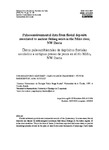Palaeoenvironmental Data From Fluvial Deposits Associated to Ancient Fishing Weirs in the Miño River, NW Iberia

Ver/
Use este enlace para citar
http://hdl.handle.net/2183/27854
A non ser que se indique outra cousa, a licenza do ítem descríbese como Atribución-CompartirIgual 4.0 Internacional (CC BY-SA 4.0)
Coleccións
Metadatos
Mostrar o rexistro completo do ítemTítulo
Palaeoenvironmental Data From Fluvial Deposits Associated to Ancient Fishing Weirs in the Miño River, NW IberiaTítulo(s) alternativo(s)
Datos paleoambientales de depósitos fluviales asociados a antiguas presas de pesca en el río Miño, NW IberiaData
2020-12-28Cita bibliográfica
Sanjurjo-Sánchez, J., Arce-Chamorro, C., Barrientos, V., & Goy-Diz, A. (2020). Palaeoenvironmental data from fluvial deposits associated to ancient fishing weirs in the Miño river, NW Iberia. Cadernos do Laboratorio Xeolóxico de Laxe. Revista de Xeoloxía Galega e do Hercínico Peninsular, 42, 53-68. https://doi.org/10.17979/cadlaxe.2020.42.0.7284
Resumo
[Abstract] Fluvial sediments provide environmental records of the Quaternary. In some cases, fluvial deposits are caused by anthropogenic processes that cause changes in the water regime of some river stretches. This is the case of dams. It has been reported that some dams or partial damming systems existed in the past, at least from some thousands of years ago. Such dams were used for fishing purposes and are referred as fishing weirs. In a recently published work it has been demonstrated that a fluvial thick deposit was caused by a damming system in a river of NW Iberia (River Miño, Pontevedra). Optically stimulated luminescence (OSL) provided the burial age of such fluvial deposit, showing a 1300-year-old fluvial record. The sedimentation rates of the record did not match with known climate fluctuations in the area. In this work, the sedimentation phases of such record are identified, and the detrital and organic matter content is studied to assess any change occurred in the environmental and fluvial conditions during the deposition period of the record that ranges from 814±134 to 1837±11 AD. [Resumen] Los sedimentos fluviales pueden proporcionar registros ambientales del Cuaternario. En algunos casos, los depósitos fluviales pueden ser causados por procesos antropogénicos que provocan cambios en el régimen hídrico de algunos tramos de los ríos. Este es el caso de los actuales embalses. Algunos estudios han mostrado que en el pasado existieron algunas presas o sistemas de represas parciales, desde hace al menos algunos miles de años. Esas presas se utilizaban con fines pesqueros y se denominan fishingweirs o en Galicia pesqueiras. En un trabajo reciente se ha estudiado un depósito fluvial causado por un sistema de embalses en un río del noroeste de la Península Ibérica (rio Miño, Pontevedra). Utilizando luminiscencia estimulada ópticamente (OSL) se pudo datar la edad de deposición de estos sedimentos, obteniéndose un registro fluvial de 1300 años de antigüedad. Las tasas de sedimentación del registro no coincidían con las fluctuaciones climáticas conocidas en la zona. En este trabajo se identifican las fases de sedimentación de ese registro y se estudia el contenido detrítico y la materia orgánica para evaluar los posibles cambios que se hayan producido en las condiciones ambientales y fluviales de ese tramo del río durante el período de deposición del registro, que va de 814±134 a 1837±11 d.C.
Palabras chave
Fishing weirs
Fluvial sediments
OSL dating
Palaeoenvironment
Pesqueiras
Sedimentos fluviales
Datación por OSL
Paleoambiente
Fluvial sediments
OSL dating
Palaeoenvironment
Pesqueiras
Sedimentos fluviales
Datación por OSL
Paleoambiente
Versión do editor
Dereitos
Atribución-CompartirIgual 4.0 Internacional (CC BY-SA 4.0)
ISSN
2173-6936
0213-4497
0213-4497






